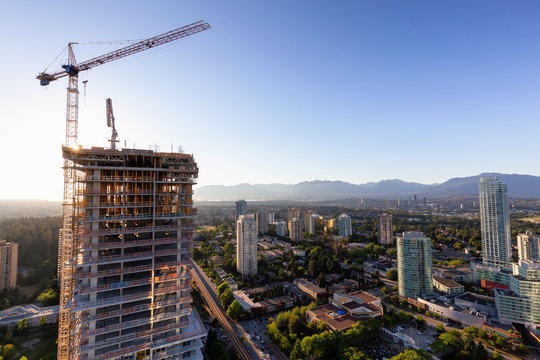India’s real estate industry is undergoing significant technological transformation, particularly in the construction of high-rise buildings. This shift is critical to supporting the country’s ambitious goal of reaching net zero emissions by 2070. With the construction industry accounting for 39% of global emissions, including 11% from building materials alone, adopting advanced, sustainable practices has become more than a trend; it is a necessity.
Pioneering Construction Technologies: The Rise of the Aluminium Formwork System (AFS)
In the field of high-rise construction, this technology has emerged as a game changer. This cutting-edge aluminum wall formwork system provides faster, higher-quality results, and greater structural integrity. Unlike traditional methods, this technology ensures consistent construction quality, speeds up project timelines, and reduces environmental impact. Its adaptability to various architectural designs, including the inclusion of service openings for HVAC and plumbing, contributes to its versatility.
The precision that this technology brings to formwork significantly reduces the need for post-construction finishes such as plastering, lowering costs while increasing durability. Its efficiency in reducing construction waste while optimizing material usage is perfectly aligned with sustainability goals, making it the preferred choice for environmentally friendly building projects.
Improving Project Efficiency through Building Information Modelling (BIM)
Building information modeling (BIM) has transformed the planning and execution of complex high-rise projects. BIM generates accurate digital models that incorporate the inputs of engineers, architects, builders, and clients, resulting in precise cost, time, and energy consumption predictions. This comprehensive approach not only simplifies project management but also allows for more efficient resource allocation, lowering the environmental impact of construction activities.
Integrating IoT for Smarter High-Rise Living.
The Internet of Things (IoT) is transforming the management and functionality of high-rise buildings. During construction, IoT improves site performance and security; afterward, it powers smart home technologies. IoT-enabled buildings provide a seamless living experience, with energy-efficient devices, advanced security systems, and remote controls. Consider a home in which smart thermostats automatically adjust to weather conditions and your refrigerator tracks inventory while recommending recipes. IoT ensures continuous connectivity, which improves home efficiency, security, and convenience.
Apps that enable property owners to monitor access and receive real-time updates on their residential complexes improve security and convenience. These innovations not only simplify life but also increase the appeal of smart homes, meeting the current demand for well-connected, intelligent living environments.
Automation enhances daily comfort and convenience.
Automation is at the heart of improving everyday life in smart homes. Integrated systems provide unparalleled convenience by transforming routine tasks into effortless experiences. Voice-activated systems can dim or brighten lights, control the climate, and provide entertainment with a single command. Automated systems also improve energy efficiency by turning off lights in empty rooms and adjusting temperature settings before the homeowners arrive.
High-end smart homes are increasingly featuring integrated wellness solutions, such as air purifiers that monitor and improve air quality and smart mattresses that track sleep patterns to help you sleep better. These innovations add significant value to the home, addressing the growing demand for holistic living experiences that prioritise health and well-being.
3D printing sets new standards in construction.
3D printing is emerging as a game changer in the Indian real estate sector. It offers a number of advantages, including faster construction times, lower costs, and increased sustainability. The technology was also used to build a 3D-printed post office in Bengaluru, which reduced construction time from 10 months to 43 days. As 3D printing technology becomes more widely available, it has the potential to transform construction practices in India by enabling more efficient and environmentally friendly building solutions.
Marketing Innovations: The Impact of AR and VR.
AR and VR are transforming real estate marketing. These technologies enable potential buyers to virtually tour properties through interactive, personalised video presentations. QR codes enable easy access to these immersive experiences, which provide a realistic sense of space and design. This innovative approach not only engages buyers but also accelerates decision-making, making it an effective tool in today’s competitive market.
Connected Communities and Smart Platforms
Smart community platforms extend the benefits of technology to entire neighbourhoods, rather than just individual homes. These platforms promote connections, share resources, and organize community events, thereby improving both individual comfort and collective well-being. This comprehensive approach to smart living emphasizes the value of community in urban settings, resulting in more connected and sustainable neighbourhoods.
Commitment to Sustainable Standards
Adherence to the National Building Code 2016 is critical to ensuring safer and more sustainable construction practices. The code requires real-time monitoring of PM2.5 and PM10 levels on construction sites, which is critical for improving air quality and minimising environmental risks. Furthermore, training construction workers to manage dust and other pollutants is critical to creating healthier urban environments.
Conclusion: Building the Future of Sustainable Urban Living.
Technological advancements in high-rise construction are rapidly transforming the real estate industry into a more sustainable future. From the implementation of AFS, BIM, and IoT to innovations in real-time inventory management and AR/VR marketing, these advancements not only improve efficiency and quality, but also significantly reduce environmental impact. As India strives for net zero emissions by 2070, the real estate sector’s commitment to sustainable practices will be critical in shaping future urban landscapes.










